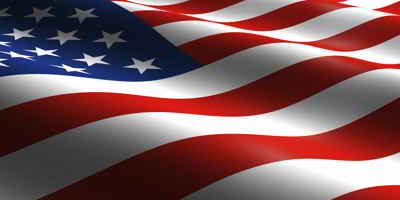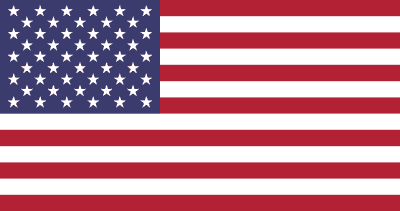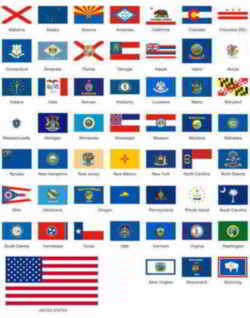

US Flag
Stars and Stripes or Old Glory
Adopted on June 14, 1777
The national flag of the United States of America, often referred to as the American flag,
consists of thirteen equal horizontal stripes of red (top and bottom) alternating with white,
with a blue rectangle in the canton (referred to specifically as the "union") bearing
fifty small, white, five-pointed stars arranged in nine offset horizontal rows of six stars
(top and bottom) alternating with rows of five stars. The 50 stars on the flag represent the
50 states of the United States of America and the 13 stripes represent the thirteen British
colonies that declared independence from the Kingdom of Great Britain and became the first
states in the Union. Nicknames for the flag include the "Stars and Stripes", "Old
Glory", and "The Star-Spangled Banner".
Flag Etiquette | Pledge | Presentation | Timeline
The US Flag
The design of the flag has been modified 26 times officially since 1777. The 48-star flag was in effect for 47 years until the 49-star version became official on July 4, 1959. The 50-star flag was ordered by President Eisenhower on August 21, 1959.
At the time of the Declaration of Independence, the Continental Congress would not legally adopt flags with "stars, white in a blue field" for another year. The flag contemporaneously known as "the Continental Colors" has historically been referred to as the first national flag.
The first flag of the colonists to have any resemblance to the present Stars and Stripes
was the Grand Union Flag, sometimes referred to as the Congress Colors, the First Navy Ensign,
and the Cambridge Flag. Its design consisted of 13 stripes, alternately red and white, representing
the Thirteen Colonies, with a blue field in the upper left-hand corner bearing the red cross
of St. George of England with the white cross of St. Andrew of Scotland. As the flag of the
revolution it was used on many occasions. It was first flown by the ships of the Colonial Fleet
on the Delaware River. On December 3, 1775, it was raised aboard Captain Esek Hopkin's flagship
Alfred by John Paul Jones, then a Navy lieutenant. Later the flag was raised on the liberty
pole at Prospect Hill, which was near George Washington's headquarters in Cambridge, Massachusetts.
It was our unofficial national flag on July 4, 1776, Independence Day; and it remained the
unofficial national flag and ensign of the Navy until June 14, 1777, when the Continental Congress
authorized the Stars and Stripes.
The Stars and Stripes originated as a result of a resolution adopted by the Marine Committee
of the Second Continental Congress at Philadelphia on June 14, 1777. The resolution read:
"Resolved, that the flag of the United States be thirteen stripes, alternate red and white; that the union be thirteen stars, white in a blue field representing a new constellation. "
The resolution gave no instruction as to how many points the stars should have, nor how
the stars should be arranged on the blue union. Consequently, some flags had stars scattered
on the blue field without any specific design, some arranged the stars in rows, and some in
a circle. The first Navy Stars and Stripes had the stars arranged in staggered formation in
alternate rows of threes and twos on a blue field. Other Stars and Stripes flags had stars
arranged in alternate rows of four, five and four. Some stars had six points while others had
eight.
Strong evidence indicates that Francis Hopkinson of New Jersey, a signer of the Declaration
of Independence, was responsible for the stars in the US flag. At the time that the flag resolution
was adopted, Hopkinson was the Chairman of the Continental Navy Board's Middle Department.
Hopkinson also helped design other devices for the Government including the Great Seal of the
United States. For his services, Hopkinson submitted a letter to the Continental Admiralty
Board asking "whether a Quarter Cask of the public Wine will not be a proper & reasonable
Reward for these Labours of Fancy and a suitable Encouragement to future Exertions of a like
Nature." His request was turned down since the Congress regarded him as a public servant.
Legend has it, the first American flag was made by Betsy Ross, a Philadelphia seamstress who was acquainted with George Washington, leader of the Continental Army, and other influential Philadelphians. In May 1776, so the story goes, General Washington and two representatives from the Continental Congress visited Ross at her upholstery shop and showed her a rough design of the flag. Although Washington initially favored using a star with six points, Ross advocated for a five-pointed star, which could be cut with just one quick snip of the scissors, and the gentlemen were won over.
Unfortunately, historians have never been able to verify this charming version of events, although it is known that Ross made flags for the navy of Pennsylvania. The story of Washington's visit to the flag maker became popular about the time of the country's first centennial, after William Canby, a grandson of Ross, told about her role in shaping US history in a speech given at the Philadelphia Historical Society in March 1870.
After Vermont and Kentucky were admitted to the Union in 1791 and 1792, respectively, two more stars and two more stripes were added in 1795. This 15-star, 15-stripe flag was the "star-spangled banner" that inspired lawyer Francis Scott Key to write the poem that later became the US national anthem.
In 1818, after five more states had gained admittance, Congress passed legislation fixing the number of stripes at 13 and requiring that the number of stars equal the number of states. The last new star, bringing the total to 50, was added on July 4, 1960, after Hawaii became a state.

The Flags of the US.





